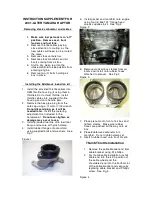
Hitches
It is important to have the correct hitch equipment.
Crosswinds, large trucks going by and rough roads
are a few reasons why the right hitch is needed.
Here are some rules to follow:
•
The rear bumper on the vehicle is not intended
for hitches. Do not attach rental hitches or other
bumper-type hitches to it. Use only a frame-mounted
hitch that does not attach to the bumper.
•
If holes need to be made in the body of the vehicle to
install a trailer hitch, then be sure to seal the holes
later when the hitch is removed. If the holes are
not sealed, deadly carbon monoxide (CO) from the
exhaust can get into the vehicle. See Engine Exhaust
on page 2-34. Dirt and water can, too.
Safety Chains
Chains should always be attached between the vehicle
and the trailer. Cross the safety chains under the
tongue of the trailer so that the tongue will not drop
to the road if it becomes separated from the hitch.
Instructions about safety chains may be provided by
the hitch manufacturer or by the trailer manufacturer.
Follow the manufacturer’s recommendation for attaching
safety chains and do not attach them to the bumper.
Always leave just enough slack so the rig can be turned.
And, never allow safety chains to drag on the ground.
Trailer Brakes
Does your trailer have its own brakes? Be sure to read
and follow the instructions for the trailer brakes so you’ll
be able to install, adjust and maintain them properly.
•
If your vehicle has antilock brakes, do not try to tap
into your vehicle’s brake system. If you do, both
brake systems will not work well, or at all.
•
Even if your vehicle does not have antilock brakes,
do not tap into your vehicle’s brake system if the
trailer’s brake system will use more than 0.02 cubic
inch (0.3 cc) of fluid from your vehicle’s master
cylinder. If it does, both braking systems will not
work well. You could even lose your brakes.
•
Will the trailer brake parts take 3,000 psi
(20 650 kPa) of pressure? If not, the trailer brake
system must not be used with your vehicle.
•
If everything checks out this far, then make the
brake fluid tap at the upper rear master cylinder port.
But do not use copper tubing for this. If you do,
it will bend and break off. Use steel brake tubing.
4-31
Summary of Contents for 2008 Allure
Page 74: ...NOTES 1 70...
Page 126: ...NOTES 2 52...
Page 129: ...NOTES 3 3...
Page 130: ...Instrument Panel Overview 3 4...
Page 226: ...NOTES 3 100...
Page 274: ...When you open the hood on the 3 8L V6 engine this is what you will see 5 14...
Page 276: ...When you open the hood on the 5 3L V8 engine here is what you will see 5 16...
Page 376: ...NOTES 5 116...
Page 390: ...Engine Drive Belt Routing 3 6L V6 Engine 3 8L V6 Engine 6 14...
Page 391: ...5 3L V8 Engine 6 15...
Page 412: ...NOTES 7 18...
















































